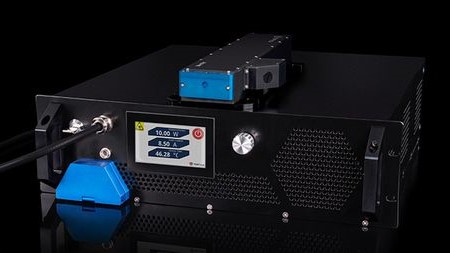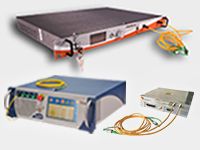master oscillator fiber amplifier (original) (raw)
Acronym: MOFA or MOPFA
Definition: a laser system containing a fiber amplifier for boosting the output power
Categories:  fiber optics and waveguides,
fiber optics and waveguides,  laser devices and laser physics,
laser devices and laser physics,  optical amplifiers
optical amplifiers
- master oscillator power amplifier
- master oscillator fiber amplifier
Related: master oscillator power amplifieroptical amplifiersfiber amplifiershigh-power fiber lasers and amplifiersDecoupling Pulse Duration and Pulse EnergyWhy Fiber Amplifiers, not Fiber Lasers?
Page views in 12 months: 630
DOI: 10.61835/5ac Cite the article: BibTex BibLaTex plain textHTML Link to this page! LinkedIn
Content quality and neutrality are maintained according to our editorial policy.
📦 For purchasing high-power fiber lasers and amplifiers, use the RP Photonics Buyer's Guide — an expert-curated directory for finding all relevant suppliers, which also offers advanced purchasing assistance.
What is a Master Oscillator Fiber Amplifier?
The term master oscillator fiber amplifier (MOFA, MOPFA, or fiber MOPA) is a variation of the term master oscillator power amplifier (MOPA), meaning a system containing a laser oscillator and a power amplifier, where the latter is a fiber amplifier. The latter is usually a cladding-pumped high-power amplifier, often based on an ytterbium-doped fiber. The main attractions of such fiber-based power amplifiers are:
- A high output power can be achieved with a high power efficiency.
- The cooling system can be relatively simple.
- The beam quality can be high; it is often close to diffraction-limited.
- The gain can easily be as high as tens of decibels. For comparison, most bulk amplifiers, particularly those with high average output power, have a much lower gain, often only of the order of 3 dB.

Figure 1: Setup of a single-stage core-pumped fiber MOPA.
For higher power levels, a second amplifier stage with double-clad fiber may be added. The seed laser diode may be operated in a pulsed regime.
However, the use of fibers also has disadvantages:
- Various kinds of optical fiber nonlinearities can make it difficult to reach very high peak powers and pulse energies in pulsed systems. For example, a few millijoules of pulse energy in a nanosecond pulse system are already considered high for a fiber device, whereas bulk lasers can provide much higher energies. In single-frequency systems, stimulated Brillouin scattering (SBS) can severely limit the output power.
- Due to the high gain, fiber amplifiers are relatively sensitive to back-reflections from a workpiece, for example. At high power levels, it is not easy to use a Faraday isolator for solving this problem, particularly when a high suppression of reflected light is required.
- The polarization state is often undefined and unstable, unless polarization-maintaining fibers are used.
It can be attractive to use a gain-switched laser diode (→ picosecond diode lasers) as seed laser for a fiber MOPA. Such devices compete with Q-switched lasers, e.g. for application in laser marking. Their advantages partly lie in their flexibility concerning output formats: it is easy to modify not only the pulse repetition rate but also the pulse duration and shape, and of course the pulse energy.
A special aspect of MOFAs is that the saturation power even of a large mode area double-clad fiber is low compared with the typical output power. Therefore, the power extraction can be as efficient as in a fiber laser, even for relatively low seed powers.
Frequently Asked Questions
What is a master oscillator fiber amplifier (MOFA)?
A master oscillator fiber amplifier, also called a fiber MOPA, is a system containing a laser oscillator (the master oscillator) that generates a seed signal, and a fiber amplifier used as a power amplifier to boost the signal's power.
What are the main advantages of a MOFA system?
MOFAs can achieve high output power with high power efficiency and excellent beam quality. They also offer very high optical gain (tens of decibels) and have relatively simple cooling requirements.
What are the primary limitations of master oscillator fiber amplifiers?
Why are MOFAs particularly flexible for pulsed applications?
Their flexibility comes from the separation of signal generation and amplification. By using a versatile seed laser, such as a gain-switched laser diode, it is easy to modify pulse parameters like repetition rate, duration, and shape.
Suppliers
Sponsored content: The RP Photonics Buyer's Guide contains 40 suppliers for high-power fiber lasers and amplifiers. Among them:
⚙ hardware
Menlo Systems' high-power fiber lasers based on erbium or ytterbium doped fiber use polarization maintaining (PM) components only. Our patented figure 9® laser technology ensures excellent stability and low-noise operation. We offer solutions for scientific research as well as laser models engineered for OEM integration.
⚙ hardware
This product line enables the power boost of lower power solution without compromise on signal quality up to 130 W. No added phase noise and very little addition of intensity noise is the key for a number of application (AMO physics, high end instrumentation).
IR fiber lasers & amplifiers: Single frequency CW output for your power hungry application: high power up to 130 W. Advanced quantum technology applications demand high performance and high power light sources. Be it gravitational wave detection or quantum computing.
VIS fiber lasers & amplifiers: Single frequency CW output for your power hungry application: High power up to 10 W and ultra-low intensity noise. Industrial applications like high performance metrology in the semicon industry or quantum computing require extremely stable, reliable and powerful laser sources.
⚙ hardware
Serving North America, RPMC Lasers offers a variety pulsed and CW fiber lasers and fiber amplifiers with wavelengths between ≈1 and ≈1.5 microns (harmonics and OPA wavelengths available). These fiber lasers can be configured in an OEM or turnkey system, with pulsed versions available from ≈200 fs up to 125 ns with rep rates from single shot up to 20 MHz. Applications include material processing, LIDAR, micromachining, intra-satellite free-space communications, telecom, and more. Standard and custom options available. Let RPMC help you find the right laser today!
⚙ hardware
Lumibird manufactures an extensive range of mature and custom-designed optical fiber amplifiers and fiber lasers. High output powers are achieved through the use of double cladding fibers pumped by broad stripe diodes. Several varieties of pumping techniques are used each optimized for specific applications. Lumibird also develops key components for producing unique and innovative light sources.
⚙ hardware
MPBC specializes in high-power fiber lasers and amplifiers, offering solutions tailored for single-frequency and high-power applications across their telecommunications, space and laser product lines. In their telecommunications lineup, MPBC's 2RU Boosters deliver up to 30 dBm of output power, ideal for demanding telecom and utility network applications in the terrestrial or submarine fields.
With TRL-9 optical amplification technology and 30 years of experience in providing optical amplifiers for submarine and terrestrial communications, MPBC is now a leading supplier of optical amplifiers for space applications. Some product offerings include:
- Space amplifiers with up to +37 dBm of output power
- Ground station amplifiers with up to 50 W of output power
In the fiber laser product line, MPBC's continuous wave near-IR lasers provide exceptional high-power performance, with air-cooled packages reaching up to 50 W and water-cooled options ranging from 50 W to over 100 W. Their single-frequency Raman fiber amplifiers and lasers are designed for precision and stability, delivering low phase and intensity noise, narrow spectral linewidths, and long coherence lengths. These systems amplify single-frequency seed sources from milliwatts to several watts in the NIR, enabling frequency doubling for stable, narrow-linewidth, low-noise visible output.
Questions and Comments from Users
Here you can submit questions and comments. As far as they get accepted by the author, they will appear above this paragraph together with the author’s answer. The author will decide on acceptance based on certain criteria. Essentially, the issue must be of sufficiently broad interest.
Please do not enter personal data here. (See also our privacy declaration.) If you wish to receive personal feedback or consultancy from the author, please contact him, e.g. via e-mail.
By submitting the information, you give your consent to the potential publication of your inputs on our website according to our rules. (If you later retract your consent, we will delete those inputs.) As your inputs are first reviewed by the author, they may be published with some delay.









